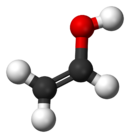Vinyl alcohol
| |||
| Names | |||
|---|---|---|---|
| IUPAC name
Ethenol
| |||
| Other names
Hydroxyethene
Hydroxyethylene | |||
| Identifiers | |||
3D model (JSmol)
|
|||
| ChEMBL | |||
| ChemSpider | |||
| ECHA InfoCard | 100.008.350 | ||
PubChem CID
|
|||
CompTox Dashboard (EPA)
|
|||
| |||
| |||
| Properties | |||
| C2H4O | |||
| Molar mass | 44.053 g/mol | ||
Except where otherwise noted, data are given for materials in their standard state (at 25 °C [77 °F], 100 kPa).
| |||
Vinyl alcohol, also called ethenol (IUPAC name), is an alcohol. It is not to be confused with the drinking alcohol, ethanol. With the formula Template:CarbonTemplate:Hydrogen2CHTemplate:OxygenH, vinyl alcohol is an isomer of acetaldehyde and ethylene oxide. Under normal conditions, it converts (tautomerizes) to acetaldehyde:
Relationship to polyvinylalcohol
Because of the instability of vinyl alcohol, the thermoplastic polyvinyl alcohol (PVA or PVOH) is made indirectly by polymerization of vinyl acetate followed by hydrolysis of the ester bonds (Ac = acetyl, HOAc = acetic acid):
- n CH2=CHOAc → (CH2-CHOAc)n
- (CH2-CHOAc)n + n H2O → (CH2-CHOH)n + n HOAc
As a ligand
Several metal complexes are known that contain vinyl alcohol as a ligand. One example is Pt(acac)(η2-C2H3OH)Cl.[1]
Occurrence in interstellar medium
Vinyl alcohol was discovered in the molecular cloud Sagittarius B using the 12-meter radio telescope at the Kitt Peak National Observatory.[2] This vinyl alcohol being stable in the (dilute) interstellar medium shows that its tautomerization is not unimolecular.
See also
References
- ^ F. A. Cotton, J. N. Francis, B. A. Frenz, M. Tsutsui "Structure of a dihapto(vinyl alcohol) complex of platinum(II)" Journal of the American Chemical Society, 1973, volume 95, p. 2483-6. doi:10.1021/ja00789a011
- ^ "Scientists Toast the Discovery of Vinyl Alcohol in Interstellar Space". National Radio Astronomy Observatory. 2001-10-01. Retrieved 2006-12-20.



